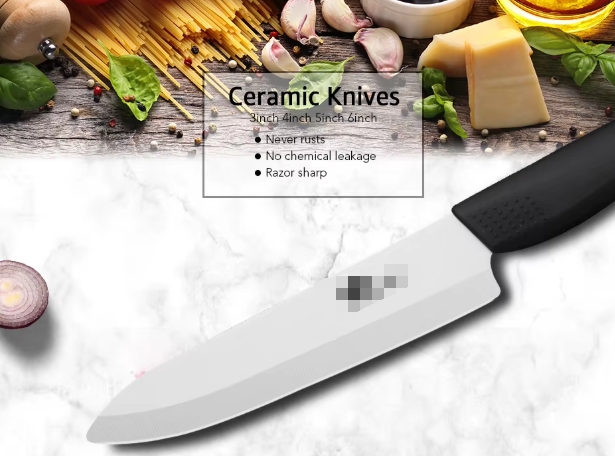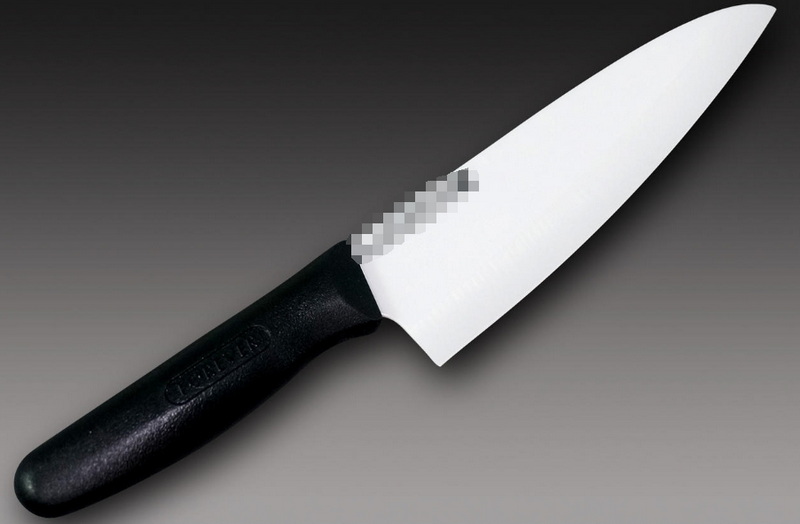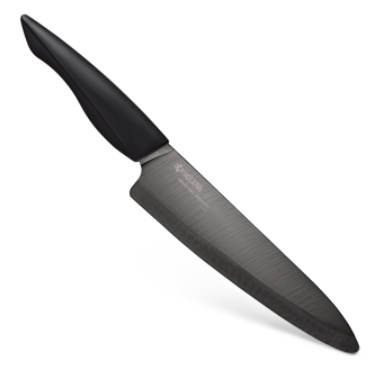

Views: 222 Author: Ella Publish Time: 2025-04-17 Origin: Site








Content Menu
● The Origins: East Meets West
● Anatomy of the Santoku Knife
● Blade Design and Edge Profile
● Cutting Techniques: Rocking vs. Chopping
● Pros and Cons Comparison Table
● How to Choose: Chef Knife or Santoku?
● FAQ
>> 1. What are the main differences between a chef knife and a santoku knife?
>> 2. Can I use a santoku knife for the same tasks as a chef knife?
>> 3. Which knife is better for beginners?
>> 4. Why do some santoku knives have a scalloped or granton edge?
>> 5. How should I care for and sharpen my chef or santoku knife?
Choosing the right kitchen knife is crucial for both professional chefs and home cooks. Among the most popular and versatile options are the chef knife and the santoku knife. While they may appear similar at first glance, these two knives have distinct origins, designs, and best-use scenarios. This comprehensive guide explores every aspect of the chef knife vs santoku knife debate, helping you determine which blade best suits your culinary needs.

The chef knife and the santoku knife are the backbone of kitchens worldwide. While both are multipurpose tools, their subtle differences can have a significant impact on your cooking experience. Understanding their unique features and advantages will empower you to make informed decisions, whether you're dicing vegetables, slicing meat, or mincing herbs.
Chef Knife:
The Western chef knife, often called the French or German chef's knife, originated in Europe and has evolved into a kitchen staple renowned for its versatility and robust design[4][5].
Santoku Knife:
The santoku knife hails from Japan and was developed in the mid-20th century as an all-purpose tool for slicing meat, fish, and vegetables. “Santoku” translates to “three virtues,” reflecting its ability to handle three key tasks: slicing, dicing, and chopping[1][5][12].
- Blade Length: Typically 8–10 inches (20–25 cm), though smaller and larger versions exist[4][5].
- Blade Shape: Curved edge with a pointed tip, allowing for a rocking motion[4][5].
- Blade Thickness: Generally thicker and heavier than a santoku, providing strength for tougher tasks[6][7].
- Bevel: Double-bevel, sharpened on both sides[3][5].
- Bolster: Usually features a bolster (thick junction between blade and handle) for safety and balance[1][5].
- Handle: Full tang construction is common, offering durability and balance[10].
- Blade Length: Shorter, usually 5–7 inches (13–18 cm)[1][5][11].
- Blade Shape: Wide, sheepsfoot blade with a straight edge and rounded spine that slopes downward to meet the edge[1][4].
- Blade Thickness: Thinner and lighter, designed for precision[1][5].
- Bevel: Can be single or double-bevel; single-bevel santokus can achieve a sharper angle for finer cuts[1][5].
- Edge: Often features a granton (scalloped) edge to reduce food sticking[1][3].
- Bolster: Rarely includes a bolster, contributing to its lighter feel[1][5].
- Handle: May be partial or full tang; Japanese handles are often lighter and more blade-heavy[10].
| Feature | Chef Knife | Santoku Knife |
|---|---|---|
| Blade Length | 8–10 inches (20–25 cm) | 5–7 inches (13–18 cm) |
| Blade Shape | Curved edge, pointed tip | Straight edge, sheepsfoot tip |
| Blade Thickness | Thicker, heavier | Thinner, lighter |
| Edge Type | Double-bevel | Single or double-bevel |
| Granton Edge | Rare | Common |
| Bolster | Usually present | Rare |
Chef Knife:
- Rocking Motion: The curved edge and pointed tip make the chef knife ideal for a rocking motion. This technique is excellent for mincing herbs, chopping vegetables, and slicing meat[4][6].
- Piercing: The pointed tip allows for piercing tasks, such as cutting into squash or breaking down poultry[2][4].
Santoku Knife:
- Up-and-Down Motion: The straight edge of the santoku is best suited for a push-cut or chopping motion. This is particularly effective for precise, thin slices of vegetables, fish, and boneless meats[4][5][6].
- Scooping: The wide blade can be used to scoop up chopped ingredients from the cutting board[11].
- Chef Knife: Heavier and longer, providing momentum for cutting through dense foods like melons, squash, and meat with bones[2][5][8].
- Santoku Knife: Lighter and shorter, offering greater control for delicate, precise cuts, especially for users with smaller hands or those who prefer a less tiring tool[1][5][7].
- Steel: Both knives are typically made from high-carbon stainless steel, though Japanese santokus may use harder, thinner steel for sharper edges[5][11].
- Edge Retention: The harder steel of santoku knives allows for a sharper edge but can be more prone to chipping. Chef knives, with softer steel, are more durable and easier to sharpen[5].
- Handle: Western chef knives often have a heavier, ergonomic handle with a full tang. Santoku handles may be lighter and more blade-heavy, especially with traditional Japanese wa handles[10].
Chef Knife:
- Chopping large vegetables (e.g., potatoes, carrots)
- Slicing meat and fish
- Mincing herbs
- Cutting through tougher foods or small bones[2][4][5]
Santoku Knife:
- Slicing, dicing, and mincing vegetables
- Precision work (e.g., thinly slicing carrots, cucumbers)
- Cutting boneless meats and fish
- Tasks requiring thin, uniform cuts[1][3][9]

| Feature | Chef Knife | Santoku Knife |
|---|---|---|
| Versatility | Highly versatile, all-purpose | Versatile, excels at precision tasks |
| Cutting Technique | Rocking, slicing, chopping | Push-cut, up-and-down chopping |
| Blade Length | Longer (8–10") | Shorter (5–7") |
| Weight | Heavier, more momentum | Lighter, easier to control |
| Edge Sharpness | Sharp, but thicker edge | Sharper, thinner edge |
| Food Release | Less likely to stick (thicker blade) | Granton edge reduces sticking |
| Best For | Large, tough foods; bulk prep | Thin, precise slices; vegetables, fish |
| Maintenance | Easier to sharpen, less prone to chipping | Holds edge longer, but can chip |
| Handle | Full tang, ergonomic | Lighter, sometimes partial tang |
| Bolster | Present for safety and balance | Rare, lighter handle |
Consider the following when deciding which knife is right for you:
Cooking Style:
- If you frequently prepare large cuts of meat, tough vegetables, or need a multipurpose workhorse, the chef knife is ideal.
- If you focus on precision, thin slicing, and mostly work with vegetables, fish, or boneless meats, the santoku may be your best choice[1][3][5].
Hand Size and Comfort:
- Those with smaller hands or who prefer a lighter knife may find the santoku more comfortable[1][5][7].
- The chef knife's weight can be beneficial for users who want more momentum in their cuts[2][5].
Cutting Technique:
- If you prefer rocking motions, the chef knife's curved edge is superior[4][6].
- For up-and-down push cuts, the santoku's straight edge excels[4][5][6].
Aesthetic and Tradition:
- Western kitchens often favor chef knives, while Japanese or Asian-inspired kitchens may lean toward the santoku[12].
Sharpening:
- Chef knives are easier to sharpen at home due to their softer steel and double bevel[5].
- Santoku knives, especially single-bevel versions, may require more skill or professional sharpening to maintain their sharper angle[1][5].
Cleaning:
- Hand wash and dry both knives immediately after use to prevent rust and maintain edge quality[11].
- Store in a knife block or magnetic strip to protect the blade.
Edge Retention:
- Santoku knives hold a sharper edge longer but can chip if used on hard materials or bones[5].
- Chef knives are more forgiving and durable for general use[5].
Both the chef knife and santoku knife are indispensable tools in the modern kitchen. The chef knife offers versatility, strength, and familiarity, making it a go-to for a wide range of tasks, especially those requiring a rocking motion or handling tougher ingredients. The santoku knife, with its lighter weight and precision-focused design, excels at thin slicing, dicing, and chopping, particularly for vegetables and boneless proteins.
Ultimately, the best knife is the one that feels most comfortable in your hand and suits your cooking style. Many chefs and home cooks find that having both knives in their arsenal allows them to tackle any culinary challenge with confidence.

The chef knife typically has a longer, curved blade with a pointed tip, designed for rocking motions and versatile tasks. The santoku knife has a shorter, wider, and straighter blade, ideal for up-and-down chopping and precision slicing, especially for vegetables and fish[1][4][5].
While both knives are versatile, the santoku is best for precision work and thin slicing, while the chef knife is better for tasks requiring more force or a rocking motion, such as cutting large vegetables or meat with bones[2][4][5].
Beginners may find the santoku easier to control due to its lighter weight and shorter blade, especially for tasks like slicing and dicing vegetables. However, the chef knife's versatility makes it a solid all-around choice[1][5][9].
The granton edge features small divots or scallops along the blade, which help reduce food sticking to the knife, making it easier to achieve clean, uniform cuts, especially with starchy or moist ingredients[1][3][11].
Both knives should be hand washed and dried immediately after use. Chef knives are easier to sharpen at home, while santoku knives, especially single-bevel versions, may require professional sharpening to maintain their sharper edge[1][5][11].
[1] https://kamikoto.com/blogs/fundamentals/difference-between-chefs-knife-and-santoku-knife
[2] https://www.youtube.com/watch?v=zMbGFkPIjEI
[3] https://www.chefs-edge.com.au/blogs/knife-information/chef-or-santoku-whats-the-difference
[4] https://www.knivesandtools.com/en/ct/chefs-knife-versus-santoku.htm
[5] https://imarku.net/blogs/knife-blog/santoku-vs-chef-knife
[6] https://www.youtube.com/watch?v=N46Bany7mus
[7] https://lifebymikeg.com/blogs/all/when-to-use-santoku-vs-chef-knife-a-home-cooks-guide
[8] https://santokuknives.co.uk/blogs/blog/what-is-the-difference-between-a-chefs-knife-and-santoku
[9] https://www.reddit.com/r/food/comments/bpyiy/santoku_vs_chefs_knife/
[10] https://www.reddit.com/r/chefknives/comments/vg640g/chefs_knives_vs_santoku_knives/
[11] https://madeincookware.com/blogs/santoku-vs-chef-knife
[12] https://www.chuboknives.com/blogs/news/santoku-vs-chef-knife
[13] https://www.reddit.com/r/chefknives/comments/vg640g/chefs_knives_vs_santoku_knives/
[14] https://fnsharp.com/blogs/fns/santoku-vs-chef-knife
[15] https://www.chuboknives.com/blogs/news/santoku-vs-chef-knife
[16] https://www.thecookingguild.com/blogs/news/santoku-vs-bunka-vs-chef-knife
[17] https://www.youtube.com/watch?v=PgVgu-DwxJQ
[18] https://hexclad.com/blogs/posts/santoku-knife-vs-chef-knife
[19] https://www.youtube.com/watch?v=jjJek9blD5U
[20] https://www.seriouseats.com/the-best-essential-knives
[21] https://www.youtube.com/watch?v=aTFt12xVyUs
[22] https://www.tiktok.com/@kellyscleankitchen/video/7345603404183522606
[23] https://www.youtube.com/watch?v=GjHaMLsHUUQ
[24] https://www.youtube.com/watch?v=CGxYZQrdnmY
[25] https://www.reddit.com/r/AskCulinary/comments/17x2i8/santoku_vs_chefs_knife_when_to_use_which/
[26] https://stahlkitchens.com/blogs/news/santoku-vs-chef-knife
[27] https://www.blackmoorhome.co.uk/blog/a-guide-to-different-types-of-kitchen-knives/
[28] https://www.ecoleducasse.com/en/blog/santoku-vs-chef-knife
[29] https://cooking.stackexchange.com/questions/834/what-are-the-advantages-of-a-santoku-over-a-french-chefs-knif
What's the Difference Between a Kitchen Knife and a Carving Knife?
What's the Difference Between a Paring Knife and a Kitchen Knife?
What's the Difference Between High Carbon and Stainless Steel Kitchen Knives?
What's the Difference Between Forged and Stamped Kitchen Knives?
What's the Difference Between a Chef's Knife and a Kitchen Knife?